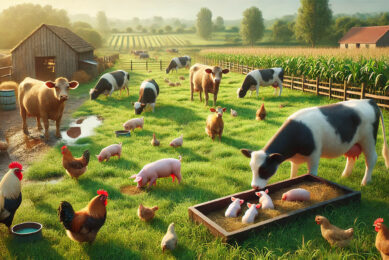Added value of esterified organic acids

The financial success of animal rearing is directly related to gut health. To avoid performance losses, it is of utmost importance for farmers and veterinarians to closely monitor the development of the gut mucosa and associated microbiota.
The intestine is the most predominant gate between expensive feed input and qualitative production output. The huge surface area of the intestinal mucosa is constantly in direct contact with the luminal content. This mucosal barrier is providing an adequate protection against the invasion of pathogenic bacteria, viruses and toxins, but is also assuring an optimal absorption of nutrients. Fulfilling both functions simultaneously requires a well-balanced rich and diversified microbiome composition, specifically located along the intestinal tract. Any factor compromising the intestinal mucosa’s integrity and microbial balance will affect animal health and performance in commercial operations.

Organic acids
Organic acids are widely present in nature. They occur in plants, animals and humans, and are produced by intestinal bacterial fermentation of fibres, starches and sugar. Organic acids are called Short Chain Fatty Acids (SCFA) when containing less than 6 carbon atoms, and Mid Chain Fatty Acids (MCFA) when containing 6 to 14 carbon atoms. Some organic acids have a long history of use as preservative. The antimicrobial action of organic acids as preservative in feed or drinking water occurs through lowering the pH, reducing the feeds buffering capacity and affecting the microbial population in feed or water. More important, however, is the fact that organic acids can also have beneficial effects inside an animal’s digestive tract by steering the complex intestinal microbial community and enhancing the integrity of the intestinal mucosa.
Esterified butyric acid
Butyric acid plays a fundamental role in the development, integrity and functionality of the gut of birds and mammals, and has received particular attention for its extraordinary beneficial effects on animal health. In order for butyric acid to improve animal gut health, it should ideally be delivered gradually along the GIT. Unfortunately, as butyric acid is a very small molecule, it gets readily absorbed in the stomach and the upper part of the small intestine, hence not reaching the entire intestine. A novel and proven technology to gradually deliver butyric acid along the GIT is known as “esterification”. Esterification is a chemical process allowing the binding of one glycerol molecule to 1, 2 or 3 organic acid molecules, forming mono-, di- or triglycerides of organic acids. Typical examples of esterified forms of butyric acid are monoglycerol butyrate, or monobutyrin, and triglycerol butyrate, or tributyrin. Both are extensively used in animal production.
Monobutyrin and tributyrin have the advantage compared to free butyric acid and its salts that they do not smell, are non-corrosive, are pH independent and are gradually released throughout the entire gut by enzymatic activity of pancreatic lipases. Worldwide scientific research and trials have confirmed the substantial benefits of butyric acid esterification, i.e. improved gut morphology, enhanced gut integrity, augmented nutrient digestion and absorption, and balanced immune system and luminal microbiota. These multifactorial benefits make mono- and tributyrins a globally accepted and widely used tool in managing optimal gut health.

Esterified MCFA’s
For many years, MCFA’s have been thoroughly investigated for their antibacterial and antiviral potential. Extended in vitro research indicated that the esterified monoglyceride form of a MCFA has superior antimicrobial activity compared to the non-esterified free mid chain fatty acid. Research also showed that the di- and triglyceride form of a MCFA has no antibacterial action and even inhibits the antibacterial activity of a monoglyceride when they co-occur.
Thanks to the amphiphilic nature of monoglycerides, the membrane of bacteria and the lipid envelope of viruses can be destroyed, consequently killing the pathogens. The longer the MCFA monoglyceride, the higher the antibacterial activity against Gram-positive bacteria, for instance glycerol monocaproate (C6) < glycerol monocaprylate (C8) < glycerol monocaprate (C10) < glycerol monolaurate (C12). Gram-negative bacteria are known to be more sensitive to shorter MCFA monoglycerides.
Due to the worldwide increasing antimicrobial resistance awareness, the industry has intensively explored alternatives to reduce the use of antibiotic growth promoters in livestock production. A consensus amongst scientists and veterinarians exists in the fact that a multifaceted approach is required to produce healthy animals without extensive use of in-feed antibiotics. Esterified MCFA’s are a scientifically and commercially proven and popular in-feed solution thanks to their strong antibacterial, antiviral and immunity enhancing effects. Adding MCFA esters to the feed avoids excessive inflammation at gut level and generates a more resilient microbiome. This results into increased vaccination efficiency and higher animal performance, without antimicrobial resistance.
Essential part of diets
Modern antibiotic-lean animal farming relies on a well-oiled approach, bringing together good manufacturing practices, highly evolved genetics and optimised diets. Specialty feed ingredients are an essential part of these diets. It is increasingly recognised and accepted that financial success of animal rearing is directly linked to animal health in general and intestinal health more specifically. Carefully selecting the right type and combination of ingredients is vital. Many years of research and development by Proviron and others have indisputably demonstrated that the selective esterification of organic acids adds major benefits both inside and outside the animal. Each animal production has its own particular challenges. These can be met by using different types/forms/combinations/dosages of glycerides, each having different modes of action. It is highly recommended and useful for farmers, veterinarians and nutritionists to request professional advice in selecting the most appropriate products for their specific needs. Proviron having many years of experience and know-how in Animal Health manufactures high purity fatty acid esters (pureLine range) and patented gut health improving concepts for poultry (Optigut), swine (Porcestin) and aquaculture (Optigut Aqua), emphasising the synergistic effects of combining carefully selected ingredients for specific animal challenges.
Author:
Dr Julie Feyaerts, Product Development Manager, Proviron, Belgium
Join 13,000+ subscribers
Subscribe to our newsletter to stay updated about all the need-to-know content in the dairy sector, two times a week.






